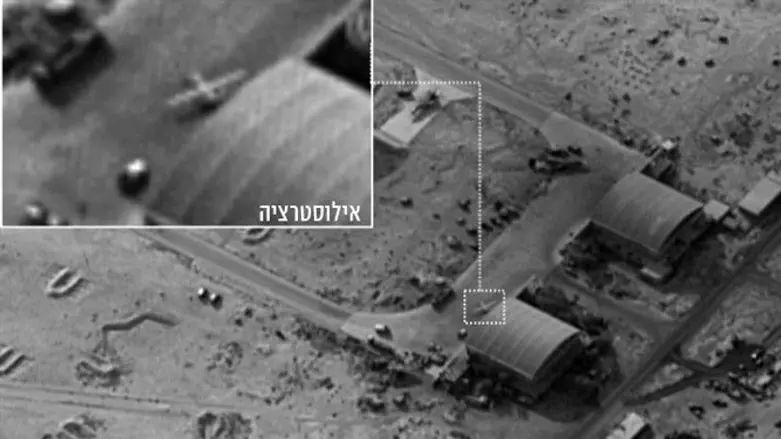
After Syrian air defenses tried to down an IAF warplane patrolling the skies in northern Israel at the beginning of last week, two other confrontations took place over the weekend.
On Saturday evening two rockets were fired in the direction of the Israeli Golan Heights with one of them reaching Mount Hermon where it exploded without causing damage or casualties.
The Israeli air force (IAF) responded by launching airstrikes on positions of Hezbollah and the Quds Force of the Iranian Revolutionary Guards Corps (IRGC) in the vicinity of Damascus, killing three Syrian soldiers and 7 members of Hezbollah and the Quds Force.
The Quds Force and Hezbollah have bases near Al-Husseiniyah and Al-Kiswah south and south-west of Damascus which have been bombed by the IAF before this.
Early Monday morning the IAF again carried out airstrikes against Iran-related targets in Syria.
IAF warplanes launched missiles at the Tiyas or T-4 base near Homs in northwest Syria and reportedly destroyed a weapons storage and several other military facilities belonging to the Quds Force.
The Syrian Observatory for Human Rights reported 5 casualties as a result of this IAF strike against the Iranian entrenchment in Syria.
It remains unclear if the Israeli warplanes actually entered Syrian airspace. Earlier airstrikes against the T-4 base and other Iranian military facilities in northern Syria have often been carried out from Lebanese airspace after Russia sold its S-300 anti-aircraft missile shield to the Syrian army.
Military experts think it’s entirely possible that IAF warplanes still enter Syrian airspace in order to act against the Iranian axis and that the fact that the Syrians never used their S-300 systems against the Israelis indicates the use of the sophisticated anti-aircraft shield requires Russian approval.
The Russian ban on the use of the S-300 system against Israeli warplanes operating in Syria could be the result of understandings reached between Russian President Vladimir Putin and Israeli Prime Minister Benyamin Netanyahu, observers think.
What is clear, however, is that Iran has no intention of stopping its entrenchment in Syria and is apparently testing Israel’s resolve.
The Quds Force is currently establishing a naval base at the port of Tartus in the Latakia Province and is also training Shiite militias in northern Syria in the use of attack drones.
Iran’s Iraqi proxy, the Hashd al-Shaabi umbrella organization of predominantly Shiite militias, is slowly taking over eastern Syria and is building a new border crossing near the town of Abukamal on the Iraqi Syrian border.
The construction of the new crossing and a new highway connecting Tehran with the Iraqi border became necessary because the US military controls the At-Tanf border crossing further to the east along the highway from Baghdad to Damascus.
The activities by Hashd al-Shaabi in eastern Syria have already led to the frictions and fighting with the Syrian military which aims to regain control over eastern Syria.
In southern Syria, the Quds Force is currently recruiting former rebels for a new force which is preparing for a confrontation with the Israeli military in the Quneitra region.
The force reportedly has 2,000 fighters at its disposal and consists of 36 local militias whose fighters receive salaries of between $250 and $1,500 per month.
The Iranians, furthermore, deliberately provoked the Israeli military by launching the two missiles Saturday evening and are increasingly threatening the Jewish state via proxies in Lebanon, Syria and Gaza.
In Lebanon, Hezbollah leader Hassan Nasrallah again threatened Israel with war during a speech in honor of al-Quds day and said that in the event of war between Iran and the US, Israel and Saudi Arabia would pay the price.
The Hezbollah boss also said that whenever Israel dared to act against Iranian missile facilities in Lebanon his organization would react “immediately and powerfully."
Israel recently shared intelligence (including satellite images) with the US about the exact locations of the Iranian guided missile facilities in Lebanon and delivered a stern warning to the Lebanese government via the Trump Administration.
In Gaza, meanwhile, the Iranian-backed Palestinian terror organizations Hamas and Islamic Jihad continue their low-intensity warfare against Israel by launching incendiary balloons and kites daily. Hamas leader Yahya Sinwar openly admitted Iran was behind the recent escalation with Israel.
“Iran provided us with rockets, and we surprised the world when our resistance targeted Beersheba,” Sinwar said adding that “had it not been for Iran, the resistance in Palestine would not have possessed its current capabilities.”
The Hamas leader also warned that Tel Aviv would be a prime target in any future confrontation with Israel. Despite countless Israeli airstrikes on military targets in Gaza, Hamas and Islamic Jihad’s arsenal of rockets and missiles is still estimated at 20,000 and continues to grow.
Israel now appears to work in tandem with Saudi Arabia to contain Hamas (read Iran) in Gaza.
The Saudi authorities have arrested 60 Hamas operatives over the last two months, media reported.
Israel is ready for any Iranian proxy attack, a senior Israeli navy commander said on Monday but Ron Ben Yishai, one of Israel’s military analysts, begs to differ.
In an article for the Hebrew language YNet news site Ben Yishai wrote that “Israel’s enemies understand the psychological, spiritual, cultural and political fabric of Israeli society” and the Israeli military is “paralyzed”.
The Ynet analyst said that “Iran has a credible capability to threaten Israel with nuclear weapons and ballistic missiles”.
His comments came shortly before German Intelligence confirmed Iran has a progressing program for the development of weapons of mass destruction.